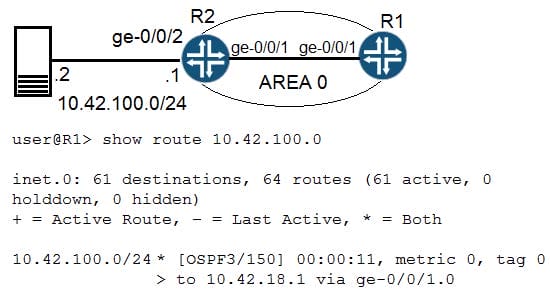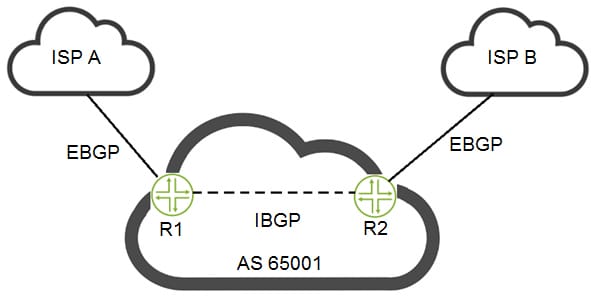Exam Details
Exam Code
:JN0-648Exam Name
:Enterprise Routing and Switching, Professional (JNCIP-ENT)Certification
:Juniper CertificationsVendor
:JuniperTotal Questions
:90 Q&AsLast Updated
:Apr 17, 2024
Juniper Juniper Certifications JN0-648 Questions & Answers
-
Question 31:
Click the Exhibit button.

You are configuring an EVPN overlay to allow VLANs to be stretched between two campus sites, but EVPN routes are not being exchanged.
Referring to the exhibit, which configuration statement would solve this problem?
A. Apply the delete protocols bgp groupEVPN cluster 172.1.1.55configuration on MX2.
B. Apply the set protocols bgp group EVPN family inet-vpn anyconfiguration on MX1 and MX2.
C. Apply the delete protocols bgp group EVPN multipath multiple-as configuration on MX1 and MX2.
D. Apply the set protocols bgp group EVPN family evpn signaling configuration on MX2.
-
Question 32:
In a Layer 2 environment where 802.1X is deployed, which two statements are correct? (Choose two.)
A. RADIUS messages are exchanged between the supplicant and the authenticator.
B. RADIUS messages are exchanged between the authenticator and the authentication server.
C. Extensible Authentication Protocol messages are exchanged between the authenticator and the authentication server.
D. Extensible Authentication Protocol messages are exchanged between the supplicant and the authenticator.
-
Question 33:
In IS-IS, advertising PDUs with the overload-bit has which effect?
A. The local device will no longer be used for transit traffic.
B. The IS-IS adjacencies enter the “new” state.
C. The local device's PDUs are marked with a metric of 65535.
D. The IS-IS adjacencies become passive.
-
Question 34:
Which two statements are true about IS-IS levels? (Choose two.)
A. Level 1 systems use a default route to reach AS external routes located in other areas.
B. Level 2 systems must use the loopback address as a part of the ISO network address.
C. Level 1 systems only from adjacencies with other systems that have different area IDs.
D. Level 2 systems do not advertise Level 2 routes into a Level 1 area by default.
-
Question 35:
Click the Exhibit button.

Referring to the exhibit, which statement is correct?
A. This router is connected to 27 different areas.
B. This router is an ASBR.
C. This router is an ABR.
D. This router originated the LSA.
-
Question 36:
Which two statements about OSPF routing policies are correct? (Choose two.)
A. By default, OSPF export policies reject network-summary LSAs.
B. By default, OSPF export policies accept network-summary LSAs.
C. By default, OSPF import policies accept network-summary LSAs.
D. By default, OSPF import policies reject network-summary LSAs.
-
Question 37:
Click the Exhibit button.

Referring to the exhibit, how is R1 learning the route from R2?
A. R2 has an export policy with external type 2 configured.
B. R2 has interface ge-0/0/2 configured as a passive interface under OSPFv3.
C. R2 has interface ge-0/0/2 configured in another area under OSPFv3.
D. R2 has an export policy with external type 1 configured.
-
Question 38:
Click the Exhibit button.

You are configuring BGP policies for a site with a dual-homed connection as shown in the exhibit. You must ensure that inbound traffic from Internet hosts flow through the ISP A connection.
Which statement is correct in this scenario?
A. Apply a BGP export policy to R2 to prepend [65001 65001 65001 65001 65001] to the AS path of routes advertised to ISP B.
B. Apply a BGP export policy on R1 to assign a lower MED value to routes advertised to ISP A.
C. Apply a BGP export policy on R2 to assign a lower origin value to routes advertised to ISP B.
D. Apply a BGP export policy on R1 to assign a higher local preference value to routes advertised to ISP
A.
-
Question 39:
Click the Exhibit button.

You have configured MSTP in your Layer 2 network. You are having problems with it establishing correctly.
Referring to the exhibit, what is causing the problem?
A. The region name is not correct.
B. You must assign a context ID number other than zero.
C. The MSTI-to-VLAN mapping does not match.
D. The revision number is the same on both devices.
-
Question 40:
Your network has Junos Fusion configured with MX960 routers as aggregation devices (AD) and QFX5100 switches as satellite devices (SD).
Which two statements are correct in this scenario? (Choose two.)
A. All SDs connected to a single AD must use the same software version.
B. SDs are added to the AD by configuring the cascade port on the AD.
C. The Fusion extended ports are configured on the SDs.
D. The AD runs the Junos software for all its connected SDs.
Related Exams:
JN0-102
Internet Associate, Junos(JNCIA-Junos)JN0-104
Junos, Associate (JNCIA-Junos)JN0-105
Junos, Associate (JNCIA-Junos)JN0-1101
Juniper Networks Certified Design Associate (JNCDA)JN0-1103
Design, Associate (JNCIA-Design)JN0-130
Juniper networks Certified internet specialist.e(jncis-e)JN0-1301
Data Center Design, Specialist (JNCDS-DC)JN0-1302
Data Center Design Specialist (JNCDS-DC)JN0-1331
Security Design, Specialist (JNCDS-SEC)JN0-1332
Security Design, Specialist (JNCDS-SEC)
Tips on How to Prepare for the Exams
Nowadays, the certification exams become more and more important and required by more and more enterprises when applying for a job. But how to prepare for the exam effectively? How to prepare for the exam in a short time with less efforts? How to get a ideal result and how to find the most reliable resources? Here on Vcedump.com, you will find all the answers. Vcedump.com provide not only Juniper exam questions, answers and explanations but also complete assistance on your exam preparation and certification application. If you are confused on your JN0-648 exam preparations and Juniper certification application, do not hesitate to visit our Vcedump.com to find your solutions here.